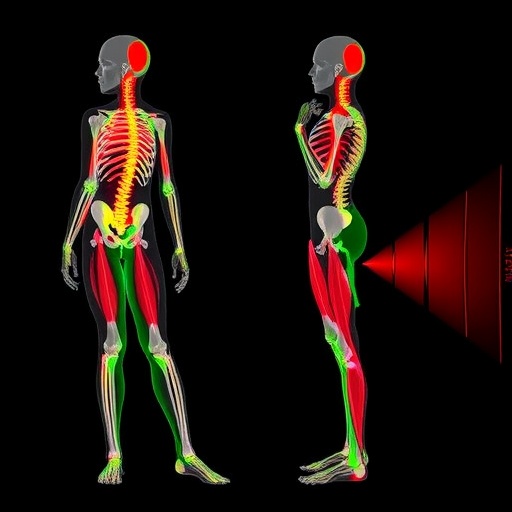Prolonged standing, a common activity that many individuals encounter in various work environments, is not without its repercussions on human physiology. Recent research conducted by Feng et al. sheds light on the intricate relationship between joint kinematics and muscle activity during extended periods of standing, followed by subsequent gait patterns. This groundbreaking study, published in the journal Annals of Biomedical Engineering, delves into the physiological ramifications of standing and the biomechanical adjustments that occur when transitioning into walking.
Standing, often overlooked, places a unique strain on the human musculoskeletal system. The static nature of this position can lead to alterations in joint angles and muscle engagement, which may not be immediately apparent to the observer. By focusing on these dynamic changes, the research team aimed to dissect how prolonged standing affects both the joints and muscle activity levels, offering essential insights into optimal ergonomic practices.
One of the primary objectives of the study was to ascertain how muscle activation patterns evolved following extended standing periods. Understanding muscle fatigue and its effects on performance during gait emergence is crucial. The findings suggest that as the duration of standing increases, so too does the likelihood of muscular fatigue, which may compromise both balance and coordination.
The implications of joint kinematics during standing are equally significant. Feng et al. illustrated how sustained periods of immobility resulted in changes to joint angles, particularly at the ankle and knee joints. This alteration can cause compensatory adaptations in other areas of the body, ultimately affecting the efficiency of gait. The study revealed that individuals might unconsciously adjust their standing posture, leading to a cascade of alterations that impact their overall biomechanics.
Furthermore, the research highlighted that muscle recruitment patterns experienced notable shifts upon transitioning from standing to walking. Initially, the muscles responsible for stabilizing the body while standing become less active as individuals switch to a more dynamic mode of movement. This transition demands a different set of muscular responses that are vital for maintaining balance and ensuring a fluid gait. Understanding these shifts paves the way for developing targeted interventions aimed at reducing the risk of musculoskeletal disorders.
Another crucial component of the study was the analysis of the temporal aspect of muscle functionality during the shift from standing to gait. The research proposed that the initial phase of walking is marked by inefficiencies, primarily caused by the lingering effects of prolonged standing. The cumulative fatigue experienced during standing may inhibit optimal muscle engagement during the initial strides of walking.
A notable recommendation emerging from this research is the importance of regular movement breaks. For individuals whose jobs demand prolonged standing, integrating short breaks that encourage shifting weight or walking can mitigate the adverse effects observed in muscle activity and joint kinematics. By implementing such strategies, practitioners might enhance their overall functional capacity and endurance during both standing and walking activities.
Additionally, the data gathered in this study can inform workplace ergonomics. Employers may invest in more dynamic workspaces that allow for alternating between standing and sitting positions. Such adjustments would not only promote employee wellness but could also lead to increased productivity by minimizing the fatigue associated with lengthy periods of standing still.
The research’s conclusions extend beyond workplace applications; they have applications in sports, rehabilitation, and even everyday activities. For athletes, optimizing the movement transition from static to dynamic usage of muscles can improve performance and prevent injury. In rehabilitation settings, understanding these mechanics can facilitate more effective recovery strategies for individuals recovering from musculoskeletal injuries caused by immobilization.
Feng et al. also emphasized the need for further research, particularly in diverse populations and varying conditions. By exploring different age groups, activity levels, and health profiles, researchers can develop a more comprehensive understanding of the effects of prolonged standing and subsequent locomotion in humans.
In conclusion, the investigation into joint kinematics and muscle activity during prolonged standing offers vital insights that extend well beyond the laboratory. The findings underscore the complex interplay between muscle fatigue, joint mechanics, and movement efficiency. As the awareness of these factors increases, it is likely that proactive measures will emerge to mitigate the health impacts associated with lengthy periods of standing.
With increasing attention being paid to workplace wellness and human factors engineering, studies like this one play an instrumental role in shaping future efforts aimed at enhancing not only occupational health but also the human experience. Integrating findings into practical applications remains paramount for fostering environments that support both individual functionality and overall wellbeing.
As we strive for better understanding and outcomes related to human movement and biomechanics, Feng et al.’s contributions will undoubtedly resonate across various fields—prompting further inquiry and innovation toward optimizing human health in our increasingly static world.
Subject of Research: The effects of prolonged standing on joint kinematics and muscle activity, and subsequent gait transitions.
Article Title: Joint Kinematics and Muscle Activity in Response to Prolonged Standing: Analysis of Standing and Subsequent Gait.
Article References:
Feng, L., Jiang, W., Li, Z. et al. Joint Kinematics and Muscle Activity in Response to Prolonged Standing: Analysis of Standing and Subsequent Gait. Ann Biomed Eng (2025). https://doi.org/10.1007/s10439-025-03800-4
Image Credits: AI Generated
DOI:
Keywords: Joint kinematics, muscle activity, prolonged standing, gait analysis, ergonomics, muscle fatigue, biomechanics, workplace wellness.




